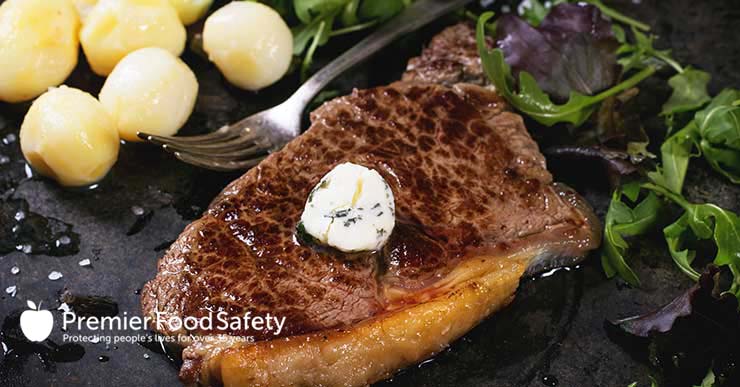Monthly Archives: December 2015
Published December 31, 2015
Customers Want Plant Protein More Than Ever
Veggie-forward menu items have gained an increasingly prominent place on restaurant menus in recent years, and the trend shows now sign of abating. Over a third of American restaurants now include at least one vegetarian entree on their menus, and almost 15 percent of the key Millennial generation eat only plant-based foods when dining out. Now more than ever, it’s key to serve vegetarian proteins at your business.
Read More: https://premierfoodsafety.com/blog/customers-want-plant-protein-more-than-ever/
Published
Which Insect Flour Makes the Best Cookies?
Catherine Lamb of Lucky Peach magazine recently went where no baker has gone before. Inspired by futurists’ predictions that humans will be forced to eat insects soon, she decided to see which type of ground-up insect made for the best Toll house chocolate chip cookies. Of the four bug flours she tried, only earthworm made […]
Read More: https://premierfoodsafety.com/blog/which-insect-flour-makes-the-best-cookies/
Published
Automation Can Save Time and Money
Automation technology has revolutionized the quick-service and fast-casual restaurant industry. These sorts of businesses use automated inventory tracking, POS systems, and food safety solutions to take some of the guesswork and labor out of running a restaurant. For some reason, full-service restaurants have been slower to embrace the automation revolution. This is a shame, because […]
Read More: https://premierfoodsafety.com/blog/automation-can-save-time-and-money/
Published December 30, 2015
Turning a Janitor Job Into a Hot Dog Empire
When Farouk Diab emigrated from Israel to the U.S. in 1975, the first job he got was as a pat-time janitor at a Wienerschnitzel. Within two years, he had worked all the jobs at the restaurant and was given the chance to become a franchisee. He’s been the number one franchisee for the chain one […]
Read More: https://premierfoodsafety.com/blog/turning-a-janitor-job-into-a-hot-dog-empire/
Published
The 15 Most Gorgeous Restaurants of ’15
Food quality is obviously the most crucial factor by which to rate restaurants, but it isn’t the only important facet of the dining experience. Well-done interior decor can elevate a restaurant from being merely good to great. Eater has collected the 15 best-looking restaurants of 2015, and boy are they stunners. Eater’s “Stone cold Stunner […]
Read More: https://premierfoodsafety.com/blog/the-15-most-gorgeous-restaurants-of-15/
Published December 29, 2015
Should Soda be Regulated Like Alcohol or Tobacco?
Former New York Times food writer Mark Bittman thinks that people shouldn’t be allowed to drink soda until they are 14 or 16 years old. Although a legal drinking age for soda is unlikely to happen anytime soon, it is true that too much soda is harmful for kids. Many food chains are responding to health risks by removing soda from their kids’ menus.
Read More: https://premierfoodsafety.com/blog/should-soda-be-regulated-like-alcohol-or-tobacco/
Published
Burger King Won Twitter With its Miss Universe Response
The Miss Universe Pageant has been all over the internet of late because host Steve Harvey initially crowned first runner-up Ariadna Gutierrez-Arevalo as the winner before realizing his mistake and taking her crown away. Burger King took advantage of the brouhaha surrounding the pageant by tweeting a picture of someone wearing a Burger King crown […]
Read More: https://premierfoodsafety.com/blog/burger-king-won-twitter-with-its-miss-universe-response/
Published
Bitter is the Next Flavor Frontier
Culinary consumers are showing a greater willingness to be challenged of late, and restaurants are taking advantage by filling their menus with bold flavors. Salty, spicy and sour have all became popular in recent years, but the newest flavor trend on American menus is bitter. Bitter first became popular in the beverage world, with cocktail […]
Read More: https://premierfoodsafety.com/blog/bitter-is-the-next-flavor-frontier/
Published December 28, 2015
Grants Are Available for World-Beating Female Chefs
The James Beard Foundation is sponsoring 22 grants for ambitious female chef/restaurateurs to be trained by top-tier chefs for a year with all their living expenses paid. This program is a great effort to reduce the gender gap in kitchens, which will be good for everyone who works in the restaurant industry.
Read More: https://premierfoodsafety.com/blog/grants-are-available-for-world-beating-female-chefs/
Published
What’s Behind the Resistance to Digital POS Systems
Many restaurants are embracing digital point-of-sale technology but a recent study showed that 63 percent of restaurants still don’t use digital POS systems. Justin Guinn, a restaurant researcher at Software Advice, says that the number one reason restaurant owners give for not switching to digital is cost. However, digital POS systems are now much more […]
Read More: https://premierfoodsafety.com/blog/whats-behind-the-resistance-to-digital-pos-systems/
ARCHIVES
- Commentary
- Want to Optimize Your Menuboards? Try Analytics
- One Coffee Shop’s Mission-Focused Approach to Marketing
- Why the Future of Sandwiches is Global
- Create a Stunning Look with Custom and Themed Table Tops
- Is Alcohol Worth the Price for Fast Casuals?
- Food Handler
- How to Compliment Guests
- Tips for balancing your job and your relationship
- More annoying customers that drive you crazy
- The tip of a lifetime
- Customers are annoying
- Food Manager
- Online ordering – the future is now!
- Improve assistant manager skills to boost business
- How to Manage and Control Food Costs
- Sustainable food is good for business (and the environment!)
- What’s the Deal with Baby Boomers?
- News
- Jimmy John Liautaud to Receive Horatio Alger Award
- Loyalogy Announces New 2018 Rewards Program Research Study with Customized Options for Restaurant Companies
- Pita Pit’s CEO Talks Fresh Menu, Future Changes
- Leaders Establish Foodservice Consulting Firm
- CoreLife Eatery Announces New Franchising Opportunities
- Quiz
- Trending





